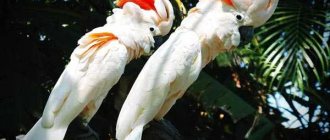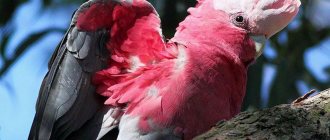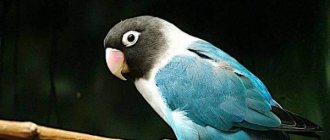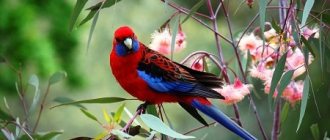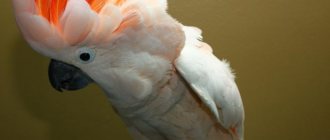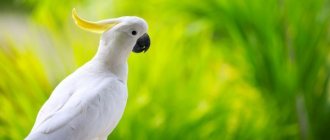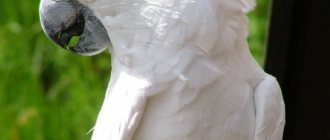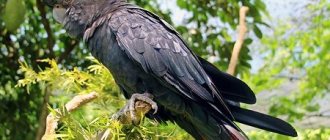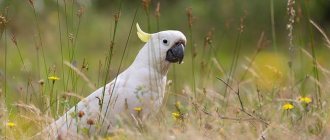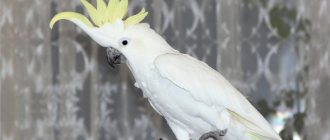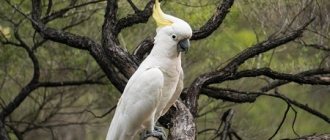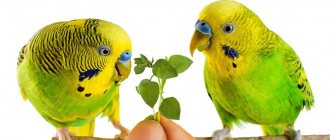The forests of Australia are home to one of the most mysterious and luxurious parrots - the black cockatoo. This bird has an original, memorable appearance and interesting habits. The species is endangered, but this only enhances the attractiveness of this overseas curiosity for breeders. Let's try to find out how black cockatoos live in nature and whether they can be kept at home. We will understand the intricacies of care, and also talk about the nuances of buying an outlandish parrot.
Appearance and habitat
This parrot is one of the largest among cockatoos: weight about 1 kg, height 65-75 cm, with the length of the tail accounting for almost 25 cm. The plumage is deep black, with only bright red spots on the cheeks. The iris of the eyes is brown. Around the eyes there are unfeathered areas of black skin. The wide and long beak is flattened on the sides, the upper part hangs over the lower part, curving. According to this feature, the parrot is similar to the macaw and is called arabid. All cockatoos are characterized by the presence of a crest - in our hero it is quite long, narrow black feathers lie in a tuft on the back of the head or form a lush cowlick on the crown.
This is interesting! When a parrot is angry, scared, excited, the skin tone on its cheeks changes from pink to scarlet. A large crest, a terrible beak and red markings on a black background give the bird a special ferocity.
The black cockatoo has another name - palm, this is due to its habitat. The species occupies a habitat within the borders of northern Australia and adjacent islands. Parrots choose dense deciduous forests. They live on tall trees: palms, eucalyptus, acacia.
Lifestyle in nature
Black palm cockatoos tend to be isolated. Rarely gather in groups of up to 10 individuals. Most cockatoo parrots live in pairs or alone. At night they rest in the crowns of tall trees. They like to have a body of water nearby where they spend the night. In the morning, the first thing the birds do is fly to a river or lake, quench their thirst, and then go in search of food.
Thanks to their strong, sharp claws, birds move well along the trunk and branches of a tree, and extract macadamia nuts and figs. Parrots consume everything they can find:
- kidneys;
- flowers;
- fruit;
- seeds.
Using sharp beaks, they remove insects and larvae from the bark - this is a favorite delicacy for birds.
Lifestyle in freedom
This species of cockatoo inhabits almost all areas of Australia. Some subspecies are characterized by seasonal migration to other areas in search of warmth, less humidity, and richer feeding grounds.
Mourning cockatoos like to settle in tropical rainforests and eucalyptus forests, acacia and casuarina plantings, savannas, bush thickets, as well as in dry areas near water sources. They spend most of the day in the shade of trees, occasionally descending to the ground. Only one subspecies of Banks' parrot collects food from the surface of the ground.
Male and female Banks' cockatoo
Banks's cockatoo feeds mainly on seeds of eucalyptus trees and some other plants, juicy fruits, and nuts. Very rarely they can eat insect larvae that inhabit rotten trees. In the northern territories of Australia, where flocks of mourning cockatoos are very numerous, they are considered pests, as they like to destroy fields of corn and peanuts. There is evidence that birds can eat watermelons, wheat, rice, field radishes, turnips, and melons.
Reproduction
The black cockatoo has a feature related to the reproduction of offspring. These birds do not begin to look for a mate at an early age, like other parrots. They are ready to hatch chicks in the eighth year of life. They retain the ability to procreate for at least forty years. Having created a pair, palm cockatoos live together constantly and never separate. Their nesting season takes place once a year and lasts from August to January.
The process of a male courting a female is interesting. The cockatoo chooses an old eucalyptus tree with a large hollow and invites the female there. The partner watches how the male builds a nest: he looks for suitable branches of willow, acacia or eucalyptus, breaks them off with his strong beak and brings them to the hollow. Next, the bird taps a piece of a branch on the edge of the hollow, listening to the sound. If everything is to your liking, this piece of wood will be split into small pieces and then placed on the bottom of the nest.
Watching the work, the female decides whether she wants to live in this nest. At some point she flies down to inspect the home. A good nest should be spacious: its diameter is 0.8-1 m, depth 0.5-2 m. For the safety of future offspring, it is better if the nesting site is located in a hollow at a high altitude. The female meticulously inspects the housing, sometimes the male has to be given several options to choose from. When the female has made her decision, she allows the male to approach her, and the couple enters the final phase of courtship.
The female lays one large egg, and the future parents incubate it together for 30 days. The birds take turns searching for food, and the male provides protection. By the end of the incubation period, a naked, blind chick weighing 18-20 g emerges from the egg. In a month it will gain a weight of approximately 250 g, and after a couple of weeks it will be fully feathered. The first flight attempts will begin when the wings are strong enough. At the age of three months, the chick flies out of the nest and feeds independently. Until the birds prepare for the next mating season, the young remain with them.
The black palm cockatoo is a long-liver. There is unconfirmed evidence that he can live up to 90 years. The average lifespan in captivity is 50 years. About 70% of wild birds die before reaching old age.
On a note! The population of black cockatoos is decreasing every year. This is due to the low reproduction rate. Only a fifth of all chicks survive to one year.
Character, abilities
This species of parrot has a bad character and is not very suitable for keeping at home. He has high intelligence, like other cockatoos. However, there is a difference in speaking ability. The black cockatoo has a specific voice, quite unpleasant, similar to a mechanical sound. Even in a normal state, the voice is creaky, and in moments of excitement the parrot simply squeals, wheezes and hisses. The speech apparatus is not suitable for reproducing clear human speech. If the bird pronounces some words, it is indistinct.
Despite its terrifying appearance, the parrot is quite delicate and careful. He shows his displeasure by bowing his head and rushing with his beak towards the enemy. The parrot does not bite, but only scares the one who pesters him. It takes a lot of effort to anger a black cockatoo and force it into a fight. However, when communicating with a bird, you must be extremely careful and not make sudden movements.
It will not be possible to tame an adult bird, since it already has an established character. This, by the way, applies to any parrot: macaw, budgerigar and other species. Education must begin when the chick has just hatched from the egg. A chick taken from its parents and raised by humans will be very affectionate and sociable. If a pet is transferred to a new owner at an early age, there is also the opportunity to raise it properly. The bird's aggressive tendencies should be suppressed and its intellectual tendencies should be developed through various training techniques.
Black cockatoo in captivity: features of keeping
Keeping a black palm cockatoo at home is expensive and difficult. The costs of care, accessories, treatment are enormous. Due to the fact that large feathered pets are very strong and aggressive, regular cage cleaning can turn into a difficult quest. Most often, palm cockatoos are found in zoos, where it is easier to provide comfortable living conditions.
Aviary
Black cockatoos deserve a larger home than the roomiest cage from the pet store. Large birds are suitable for well-equipped, reliable aviaries with thick mesh. The minimum dimensions are 3x2x2 m. In such a room the parrot will be able to fly and walk freely. Inside you can place entertainment structures and even imitate a forest thicket. The aviary is usually populated with a pair of parrots suitable for breeding or one tamed individual. It is not advisable to keep a flock of black cockatoos together.
Required parameters and equipment of the enclosure:
- The thickness of the steel mesh rods is 5 mm or more. Any other material or fine mesh will not work. With its powerful beak, the cockatoo is able to bite through very durable products.
- At the bottom of the enclosure there is a concrete base covered with sawdust on top. The parrot will not break such a floor, and the moisture-absorbing material will ensure good sanitary condition of the room.
- The roof is made of light-proof flooring. It should protect from precipitation and direct sunlight.
- Perches are thick branches fixed at different levels. There should also be perches near the feeders and drinkers.
- Steel or ceramic feeders are securely fixed to the mesh. If they just stand on the floor, the parrot will easily turn them over.
You can arrange a place to sleep inside the enclosure. This is usually a wooden house, similar to a birdhouse, but with a larger hole. A homemade shelter made from chaotically scattered branches, similar to a hut, is suitable. Another option is a small live tree in a tub. True, the cockatoo is constantly gnawing on something, and soon only the trunk may remain of the tree.
Large birds produce significant amounts of litter and droppings. Cleaning the enclosure is a necessary undertaking that takes a lot of effort and time. The floor needs to be cleaned and sprinkled with fresh sawdust every 3-4 days. Poles and feeders should be washed when they become dirty. Once a month it is recommended to completely disinfect the enclosure.
Important advice! Before cleaning the enclosure, transfer your pet to a carrier cage. If the parrot is in the enclosure and he doesn’t like something, he may attack.
Diet
The black cockatoo parrot living in captivity is limited in its diet, no matter how strange it may sound. It is not easy to provide a natural diet, close to what the bird receives in nature. Therefore, owners choose industrial mixtures for large parrots. Dry food usually includes seeds, nuts, and cereals. In addition, juicy foods are added to the menu: vegetables, herbs, fruits. This type of food is offered in the form of salad or whole fruits. It is customary to boil vegetables, with the exception of cabbage.
In the wild, birds themselves feel what substances are missing in the body. They make up for the lack of protein by absorbing insects, worms, and larvae. They dig in the ground and find useful roots, swallowing pebbles for better digestion. When kept at home, the deficiency of micro- and macroelements is eliminated with the help of special additives. They mix food with vitamin and mineral complexes, and also give the birds eggshells, chalk, and sepia.
Feeding the Blue-headed Red-necked Parrot
The blue-headed red-necked parrot's diet should be based on a grain mixture for medium-sized parrots, which should contain various types of millet, canary seed, buckwheat, oats, safflower, and a small amount of hemp.
Fruits: apple, pear, orange, banana, pomegranate, kiwi, cactus fruits and others. All this should make up about 30% of the diet.
Vegetables: carrots, celery, green beans and peas, corn.
For greens, offer various types of salads, chard, dandelion and other permitted plants. Be sure to include sprouted and steamed grains, sunflower seeds, and legumes in your diet.
For blue-headed red-necked parrots, special granulated food is also suitable. However, it is worth accustoming to it gradually.
The cage must contain sources of minerals (chalk, mineral mixture, clay, sepia, mineral stone). Offer your pet branch food.
How much does a parrot cost and how to choose
You can buy a black cockatoo in Russia only in nurseries that specialize in birds of elite species. Most chicks are exported from European nurseries at enormous cost. A young ringed fosterling with vaccinations and documents can be valued at a million rubles.
If the bird does not have a ring on its paw with a special engraving (the name of the country where the nursery is located and the date of birth of the chick), they are trying to deceive you. Most likely, this cockatoo was smuggled in. A wild bird cannot be tamed, and it may have health problems. It’s better not to buy an exotic parrot at all than to regret the purchase later.
The terrifying yet elegant black cockatoo can drive a tropical bird collector crazy. The endangered parrot is capricious and capricious. It requires special treatment. If you are not afraid of the costs of purchasing and maintaining an elite bird, you will get an intelligent and loyal feathered companion.
Purchase and price of red-tailed grays
Always purchase parrots from trusted breeders or reputable nurseries that professionally breed African Grays. Otherwise, there is a risk of buying an adult bird caught by poachers in the wild. In such a situation, you will face all the problems of taming an adult wild bird. It may also happen that you come across an absolutely wild and aggressive individual that cannot be tamed.
The price of red-tailed gray parrots can vary depending on the age of the bird, origin (bred in a nursery or caught in the wild), level of training, and place of purchase.
- You can buy a bird on the market for $300-530, but then you will have to work a lot with a wild pet to make it tame.
- For about $760-$1500 you will get an excellent representative of the Gray Gray species, tame and not afraid.
- And for $2300-3100 thousand they will offer you a well-spoken Gray, trained and not aggressive.
When purchasing a Red-tailed Gray, you must understand that you will not have a toy in your house for a pleasant pastime, but a small child who will require your attention, patience, constant intellectual games, love and care. In return, the bird that has trusted you will turn into a devoted and sensitive friend, capable of saying an encouraging phrase in difficult times and dispelling your boredom.
Look how great he can do it:
